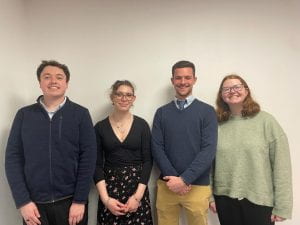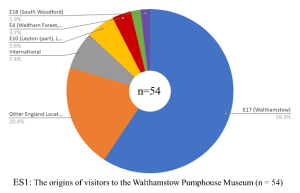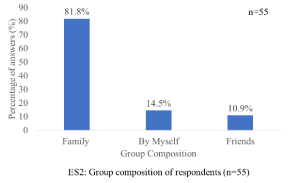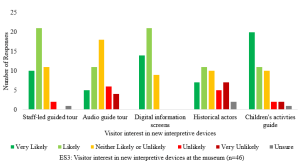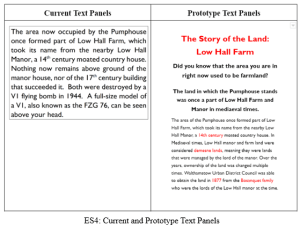Enhancing Visitor Interpretation at the Walthamstow Pumphouse Museum
Executive Summary
Education is a fundamental part of the mission of museums around the world, and a major reason why members of the public visit museums. In a recent study conducted by the Audience Agency, 55% of visitors stated that education was one of their leading motivations to attend a museum (Audience Agency, 2018, p. 8). In recent years, however, the way in which museums approach education has shifted. Museums have moved away from didactic approaches, in which visitors are seen as empty vessels to be given information, and have instead taken on a constructivist approach, in which the visitors build upon prior knowledge and become the leaders of their own learning. With this change, museums have shifted to more innovative and dynamic approaches in their interpretation.
Methods
The goal of this project was to assist the Walthamstow Pumphouse Museum in developing innovative approaches to interpretation that are more appealing, accessible, informative, and engaging for its target audiences. To accomplish this goal, we used a mixed methods approach, including: (1) conducting observations and staff interviews at the Pumphouse Museum and other museums throughout London to understand the current and best practices in museum interpretation; (2) gathering and organizing archival materials and oral histories from museum volunteers and community members to be used as supplemental materials; (3) surveying visitors to determine their perspectives on current and potential approaches to exhibits and interpretation; (4) developing prototype interpretive materials and solicited feedback on them through focus groups and discussions with museum staff.
Findings and Analysis
Our observations and interviews at other museums in London revealed five best practices: (1) include a mix of interpretive devices to accommodate different learning styles; (2) highlight key items in an exhibit using eye-catching text and bold graphics; (3) use bold synopses with more detailed descriptions for interested readers; (4) develop a learning hierarchy when creating exhibits for visitors; (5) develop a master plan for the museum to follow so they can organize their plans for the future.
Our observations at the Pumphouse Museum revealed that the museum relies heavily on text panels in the Pumphouse and the Tube Carriages areas, whereas the Fire Station relies more on guided tours by volunteers. Volunteers said they would like to see more in-depth information in addition to improvements in how the text panels are formatted. The visitor surveys reinforced that the museum is an integral part of the community. The majority (59.3%) of visitors were from the local area (ES1). 81.8% of respondents said they attended the museum with their family (ES2).
Finally, most visitors said they would be likely or very likely to use new interpretative approaches at the museum, such as staff-led guided tours, digital information screens, and children’s activities guides (ES3).
Utilizing our findings, we developed two prototype interpretive devices. These are redesigned text panels (Appendix K) and a children’s activity guide (Appendix L) that could serve as starting points for future development. We conducted a focus group with volunteers at the Pumphouse Museum to solicit feedback about these prototypes.
Participants indicated that the current text panels need refreshing and improving. They noted that current panels lacked uniformity and appeared unprofessional. Participants were concerned that the prototyped panels were too simple to appeal to adults, and that some of the information became lost. Most of the feedback focused more on the content and wording, and on inaccuracies that may be present in the original text, rather than the design and layout.
During the testing for our survey, we noticed most visitor groups that come to the museum are families. Thus, we developed two different prototypes of a children’s guide for discussion. We learned that a children’s guide was something the museum staff has wanted to offer for a long time. Participants loved the concept because it would boost engagement and interpretation for children and families. They noted that the prototype guides needed more personality, and the text was too simple and would likely only be effective for very young children.
Conclusions and Recommendations
Based on our findings, we learned about the museum’s community, the improvements the volunteers and visitors would like to see, the best practices in museum interpretation, and the materials that could be incorporated into the Pumphouse Museum. Our survey responses and interviews suggest that although members of the community want to see improvements in the museum, they also want the museum to maintain its unique personality. Our recommendations incorporate working to improve visitor interpretation while maintaining the community spirit.
Our recommendations are:
1. Develop a master plan and learning hierarchy.
2. Incorporate archival materials in reinterpretation efforts.
3. Modify and add various interpretation devices.
Develop a Master Plan and Learning Hierarchy
From our interviews, we learned that many museums develop master plans to guide their exhibit design and interpretation. Identifying a learning hierarchy for exhibits is a central part of any master plan. We recommend the museum develop a master plan to guide the future design and installation of exhibits and interpretative approaches. The master plan should identify the hierarchy of learning outcomes for the different galleries and exhibits with input from volunteers and members of the community.
Unlike larger museums, the Pumphouse Museum is very much a community museum that has developed its own quirky charm. To maintain this charm and appeal to local residents, we recommend that future developments for the museum involve close collaboration with members of the community.
Incorporate Archival Materials
Visitors indicated that a historical timeline and narrative would aid their comprehension of the exhibits. Volunteers suggested that the interpretive materials use more graphic elements that are clearly related to the exhibits and are developed following uniform design guidelines.
We recommend that the museum further review the London Metropolitan Archives, National Archives, and Vestry House Museum Archives, to identify graphic materials (such as maps and photographs) that could be used in the reinterpretation efforts.
Modify and Add Interpretive Devices
Our following suggestions relate to updating and adding interpretive devices to the Pumphouse Museum to enhance the visitor experience and understanding. We recommend interpretive devices be incorporated or updated including the text panels, a children’s activities guide, staff-led tours, an oral history device, and interactives.
We recommend that the text panels at the museum should be updated in the areas of content presentation and accessibility. Text panels were remodeled following the advice of the British Museum and the Natural History Museum (ES4).
Our surveys and observations revealed that a majority of visitors come to the Pumphouse Museum with their families, especially families with younger children. We developed prototype children’s activity guides that volunteers and visitors expressed great interest in. We recommend that the museum incorporate the use of children’s activities guides for their visitors with the prototypes serving as starting points for development.
Having a variety of interpretive devices (e.g. staff-led interpretation, self-paced interpretive devices) allows for the accessibility of the visitors of different learning types. Volunteers highlighted that there are transcripts for a guided tour of the museum’s Fire Station, the only area that currently has a tour. We recommend that the museum should develop a formal script for the Fire Station area using these recordings as well as a script for a guided tour of the entire museum.
Many of the volunteers expressed an interest in a device that allowed visitors to hear oral histories forming a greater connection between the visitors and the history. We recommend the museum reinstate a device for visitors and incorporate new oral histories.
Lastly, during the surveys, visitors expressed interest in the addition of interactive devices throughout the museum, with a primary focus for an addition of devices in the Fire Station. Interpretive devices allow for a more hands-on learning experience which can be great for children and families alike. We recommend that the museum incorporate more interactive devices starting with the addition of materials in the Fire Station.



